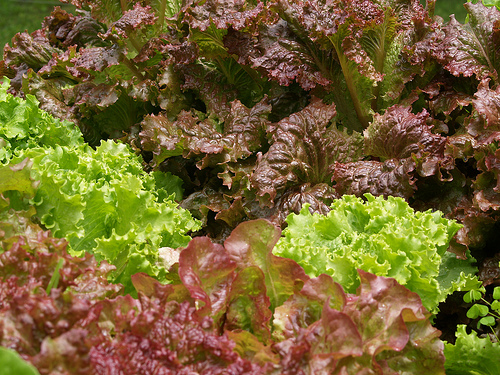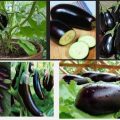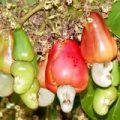Lettuce (Lactuca sativa L.) is the most popular salad vegetable. Its high fiber but low nutrient value makes it an ideal vegetable for those who watch their diet.

There are many types of lettuce. The most popular locally is the crisphead type which includes green and red iceberg varieties. The loose-leaf type includes grand rapid type varieties. Oakleaf and Lollo Rossa. Other types are Romaine/Cos and the Butterhead/Boston and Bibb lettuce.
Production Management
| Type | Variety | Leaf Color | Maturity |
| Ice berg | Great Lakes 54 | green | 45-50 |
| Great Lakes 659 | green | 45-50 | |
| West Lake | green | 45-50 | |
| Romaine/Cos | Lital | dark green | 50-60 |
| Noga | green | 50-60 | |
| Parris Island | green | 50-60 | |
| Loose-leaf | Samantha | red | 45-60 |
| New Red Fire | red | 45-60 |
Climatic Requirements
Lettuce is a semi-temperature vegetable requiring cool temperatures of 15-20oC. The iceberg varieties will not form heads in hotter areas. It can also be planted in low elevations during November to December. The quality is best in high elevations (1000 m asl).
Seedling Production
About 150-200 g of seeds is required per hectare. The best method of seedling production is by line sowing in seed boxes or nursery beds with a soil mixture of 2 parts garden soil, 2 parts manure and 1 part rice hull charcoal. Water before sowing. Make lines 7-10 cm apart. Sow 200-400 seeds/m. Cover with the same mixture and mulch with rice hull of fine rice straw. Water daily and prick to nursery trays with the same soil mix after germination. Maintain under partial shade and harden by exposure to full sunlight one week before transplanting. The seedlings are ready for transplanting 3-4 weeks from sowing.
Land preparation
Prepare the land thoroughly. Make beds 0.75 – 1.0 m wide. Incorporate generous amounts of animal manure at 10-20 t/ha. Use rice hull to improve soil texture.
Transplanting
Water the beds properly before transplanting. If rice straw is available, mulch the beds and transplant at 30-40 cm x 30-40 cm, 2-3 rows/bed. It is best to intercrop onion, chives or garlic in the beds with marigold.
Irrigation
Water the plants regularly. Use furrow irrigation, if available. Mulching helps conserve soil moisture.
Fertilization
Apply sufficient animal manure at transplanting. Use tea manure or legume tea once a week, or as needed. Prepare tea manure by soaking manure in plastic drum. After two days, the resulting mixture, tea manure, is used as fertilizer to boost plant growth. Legume tea is prepared by soaking leaves of ipil-ipil or madre de cacao in water. The mixture is ready after 6-10 days.
At transplanting, use 10g 14-14-14/hill as basal fertilizer side-dress with 5-10 g urea (46-0-0)/plant at 2-3 weeks after transplanting.
Pest and Disease Management
Lettuce has few significant pests and diseases. In case of cabbage looper and aphids, use botanical pesticides or soap solution. Bacterial rot can be minimized by sanitation.
Harvesting and Postharvest
Harvest iceberg lettuce at 45-60 days from transplanting, when heads are firm. Harvest loose leaf lettuce as needed, preferably before bolting.
For large-scale planting, sort the heads in the field and pack immediately in perforated carton boxes. If available, vacuum cooling at 1oC is best. Transport at 4oC.
Lettuce is the most important salad crop grown in most homes and school gardens throughout the country.
Its leaves are eaten raw as an ingredient of salad. It is also used as decoration for other food preparations.
The varieties commonly grown are Boston, Black Seeded Simpson, Iceberg, Grand Rapids and Great Lakes.
This vegetable is planted anytime of the year provided there is an abundant supply of water. It thrives best, however, from September to February when the climate is relatively cool.
How to Plant Lettuce
Sow the seeds in seed boxes or seedbeds. The developing seedlings are fertilized with ammonium sulphate. These seedlings are ready for transplanting 20 to 30 days after sowing.
Plow and harrow the field until the soil is reduced to a very fine tilt. The land is divided into plots one meter wide and at any desired length. Provide a working path of about 40 cm between plots.
Apply six to ten petroleum capfuls of mixed compost for every ten plots. Transplant the seedlings when two pairs of true leaves have developed at intervals of 30 cm each way. Transplant during cloudy days or late afternoon. Water immediately after transplanting and everyday thereafter for the plant’s rapid continuous growth.
Weed with bare hands or use a garden hoe.
Lettuce can be harvested in 60 to 70 days from planting. Lettuce grown for home use can be harvested when plants are big enough for use.
Aphids are the primary pests of lettuce.
The most common diseases of lettuce are Bottom Rot, Gray Mold Rot, Brown Blight and Downy Mildew. Practice crop rotation and cleanliness. For the control of these pests, consult the nearest Bureau of Plant Industry office. Cabbage (Brassica oleracea L. var. capitata L.) is considered an important part of a well-balanced diet. It is usually eaten fresh or combined with other foods.
Source: da.gov.ph







Hi Sir and Maam.
Can I ask a request to give me the name of the author for this document for my RRL thesis if you allowed me to use this page Sir.